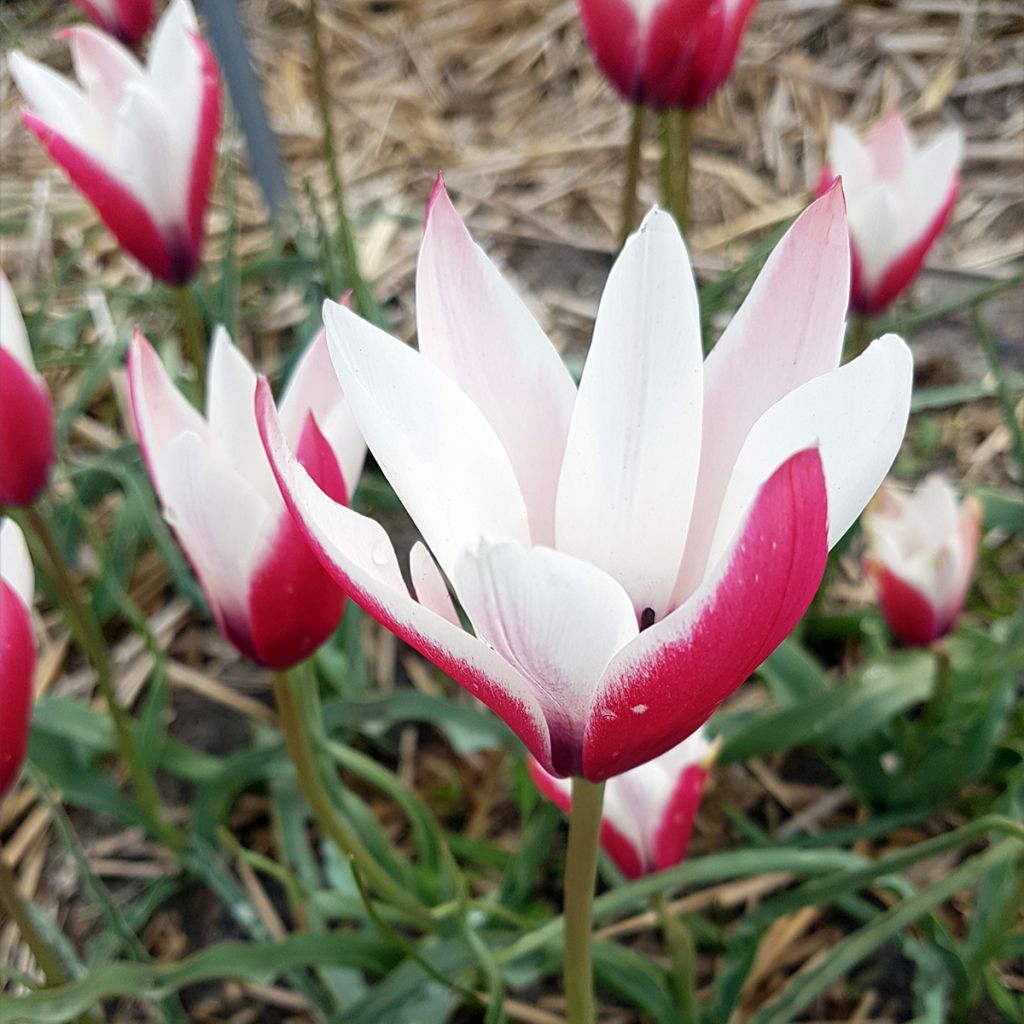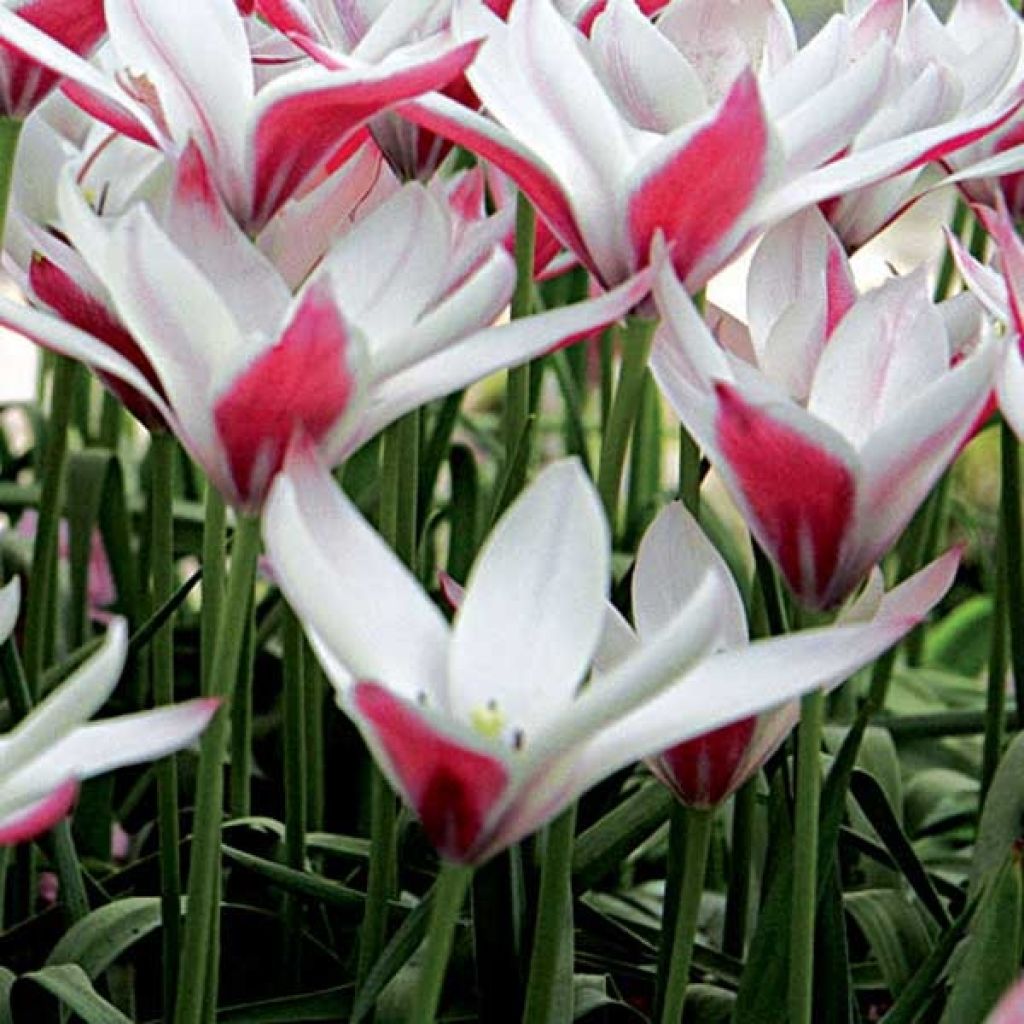

Tulipa clusiana 'Peppermintstick'


Tulipa clusiana 'Peppermintstick'


Tulipa clusiana 'Peppermintstick'


Tulipa clusiana 'Peppermintstick'
Tulipa clusiana 'Peppermintstick'
Tulipa clusiana Peppermint Stick
Tulipe de L'Écluse, Tulipe de Perse, Tulipe-radis
Great, I am delighted mine have grown up to 40cm (16in), next to my Triumph Tulips Synaeda Blue, as if to compete with them! It creates a lovely flower bed." Analysis: - "ravies" should be "delighted" - "montées" should be "grown" - "à coté de" should be "next to" - "comme pour leur faire concurrence" should be "as if to compete with them" - "parterre de fleurs" should be "flower bed
Aurore, 30/04/2023
This plant carries a 6 months recovery warranty
More information
We guarantee the quality of our plants for a full growing cycle, and will replace at our expense any plant that fails to recover under normal climatic and planting conditions.
From €5.90 for pickup delivery and €6.90 for home delivery
Express home delivery from €8.90.

Does this plant fit my garden?
Set up your Plantfit profile →
Description
The 'Perppermintstick' Tulip is a selection very close to the legendary clusiana botanical tulip, to which it bears a strong resemblance. However, it proves to be easier to cultivate and acclimate in our gardens, where it naturalizes with enthusiasm. Of similar stature, it has the same delicate and elegant flowering, white with cherry red reverses, absolutely radiant under the April sun. Carried at the top of a slender stem, its pointed petal flower opens in a sparkling white star around a violet heart. A fantastic garden bulbous plant that possesses all the charm of wild tulips!
The 'Peppermintstick' botanical tulip belongs to the lily family. The wild species Tulipa clusiana, also known as the Lady Tulip or the Tulip of L'Écluse, is native to southeastern Iran and the western Himalayas, as well as Spain, Portugal, and Italy. In France, it can be found in cultivated fields in the Midi, as far as the Rhône, Tarn, and Gironde. It is a plant that thrives in sunny, clay-limestone soil that is dry in summer. Its base colour is white. It is one of the only species of tulips that naturalizes and blooms in mild winter climates not affected by frost. Rare in the wild, it has given rise to numerous cultivars and hybrids, including 'Peppermintstick'.
This delicate tulip, with its small bulb covered in a woolly tunic, will not exceed 25cm (10in) in height when in bloom. Its foliage is a slightly greyish, bluish green, composed of narrow, linear leaves. It emerges from the ground in late winter and disappears after flowering, in late spring, before the arrival of heat. The flowers appear in April, sometimes as early as March, depending on the climate. They emerge as dark pink, very slender flower buds that blend into the surrounding vegetation. Then they open more widely, revealing a very white interior, with a base that is speckled with black-violet. Coloured pink-red on the outside, they are very elegant even when closed. They open wide in the sun and close in the evening and when the sun is hidden.
Botanical tulips do not deteriorate over time like large-flowered tulips. They naturalize and can remain in place for several years without special maintenance, and they thrive in borders and rock gardens. To create colourful scenes, they can be combined with various small bulbous plants: Crocus, Allium moly, Ipheion uniflorum, Anemone blanda, small-flowered Narcissus... These tulips are unrivaled in bringing the colours of spring to pots or sunny gardens. Clusiana tulips are highly recommended in Mediterranean gardens, where they appreciate the long, dry summers. In a dry garden, they can be accompanied by Santolinias, low lavenders, Saponaria ocymioides, thymes...
Report an error about the product description
Plant habit
Flowering
Foliage
Botanical data
Tulipa
clusiana
Peppermint Stick
Liliaceae
Tulipe de L'Écluse, Tulipe de Perse, Tulipe-radis
Cultivar or hybrid
Planting and care
Plant the Tulipa clusiana 'Peppermintstick' bulbs in autumn, from September to December, at a depth of 10cm (4in), spacing them 10cm (4in) apart. The planting should be done in ordinary soil, slightly acidic, neutral, or even calcareous, light, loose, well-worked, and above all well-draining, even sandy or loamy. Never add undecomposed manure or compost to the planting soil, as this could cause the bulbs to rot. The tulip will grow well in moist to dry soil in summer, which corresponds to its resting period. Plant it in a sunny or semi-shady location.
After flowering, their foliage becomes unsightly, so we recommend planting Tiarella, Brunnera, Euphorbia cyparissia, and Alchemilla in the foreground of your flower beds, as their foliage will enhance the colours of your tulips and later in the season, they will hide their yellowed leaves.
Advice for Flowering Carpets: You can create beautiful flowered spaces around the house, in flower beds, around trees, or in wild areas. It is an economical and sustainable solution, provided you respect a few principles:
1) It is a planting that should be left in place.
2) Choose the varieties carefully according to the situation.
3) A period of rest is essential after flowering for the bulbs to replenish themselves. Let the foliage turn yellow and dry before cutting it.
4) Organic fertilizer should be spread once a year in autumn.
Planting period
Intended location
Care
-
, onOrder confirmed
Reply from on Promesse de fleurs
Haven't found what you were looking for?
Hardiness is the lowest winter temperature a plant can endure without suffering serious damage or even dying. However, hardiness is affected by location (a sheltered area, such as a patio), protection (winter cover) and soil type (hardiness is improved by well-drained soil).

Photo Sharing Terms & Conditions
In order to encourage gardeners to interact and share their experiences, Promesse de fleurs offers various media enabling content to be uploaded onto its Site - in particular via the ‘Photo sharing’ module.
The User agrees to refrain from:
- Posting any content that is illegal, prejudicial, insulting, racist, inciteful to hatred, revisionist, contrary to public decency, that infringes on privacy or on the privacy rights of third parties, in particular the publicity rights of persons and goods, intellectual property rights, or the right to privacy.
- Submitting content on behalf of a third party;
- Impersonate the identity of a third party and/or publish any personal information about a third party;
In general, the User undertakes to refrain from any unethical behaviour.
All Content (in particular text, comments, files, images, photos, videos, creative works, etc.), which may be subject to property or intellectual property rights, image or other private rights, shall remain the property of the User, subject to the limited rights granted by the terms of the licence granted by Promesse de fleurs as stated below. Users are at liberty to publish or not to publish such Content on the Site, notably via the ‘Photo Sharing’ facility, and accept that this Content shall be made public and freely accessible, notably on the Internet.
Users further acknowledge, undertake to have ,and guarantee that they hold all necessary rights and permissions to publish such material on the Site, in particular with regard to the legislation in force pertaining to any privacy, property, intellectual property, image, or contractual rights, or rights of any other nature. By publishing such Content on the Site, Users acknowledge accepting full liability as publishers of the Content within the meaning of the law, and grant Promesse de fleurs, free of charge, an inclusive, worldwide licence for the said Content for the entire duration of its publication, including all reproduction, representation, up/downloading, displaying, performing, transmission, and storage rights.
Users also grant permission for their name to be linked to the Content and accept that this link may not always be made available.
By engaging in posting material, Users consent to their Content becoming automatically accessible on the Internet, in particular on other sites and/or blogs and/or web pages of the Promesse de fleurs site, including in particular social pages and the Promesse de fleurs catalogue.
Users may secure the removal of entrusted content free of charge by issuing a simple request via our contact form.
The flowering period indicated on our website applies to countries and regions located in USDA zone 8 (France, the United Kingdom, Ireland, the Netherlands, etc.)
It will vary according to where you live:
- In zones 9 to 10 (Italy, Spain, Greece, etc.), flowering will occur about 2 to 4 weeks earlier.
- In zones 6 to 7 (Germany, Poland, Slovenia, and lower mountainous regions), flowering will be delayed by 2 to 3 weeks.
- In zone 5 (Central Europe, Scandinavia), blooming will be delayed by 3 to 5 weeks.
In temperate climates, pruning of spring-flowering shrubs (forsythia, spireas, etc.) should be done just after flowering.
Pruning of summer-flowering shrubs (Indian Lilac, Perovskia, etc.) can be done in winter or spring.
In cold regions as well as with frost-sensitive plants, avoid pruning too early when severe frosts may still occur.
The planting period indicated on our website applies to countries and regions located in USDA zone 8 (France, United Kingdom, Ireland, Netherlands).
It will vary according to where you live:
- In Mediterranean zones (Marseille, Madrid, Milan, etc.), autumn and winter are the best planting periods.
- In continental zones (Strasbourg, Munich, Vienna, etc.), delay planting by 2 to 3 weeks in spring and bring it forward by 2 to 4 weeks in autumn.
- In mountainous regions (the Alps, Pyrenees, Carpathians, etc.), it is best to plant in late spring (May-June) or late summer (August-September).
The harvesting period indicated on our website applies to countries and regions in USDA zone 8 (France, England, Ireland, the Netherlands).
In colder areas (Scandinavia, Poland, Austria...) fruit and vegetable harvests are likely to be delayed by 3-4 weeks.
In warmer areas (Italy, Spain, Greece, etc.), harvesting will probably take place earlier, depending on weather conditions.
The sowing periods indicated on our website apply to countries and regions within USDA Zone 8 (France, UK, Ireland, Netherlands).
In colder areas (Scandinavia, Poland, Austria...), delay any outdoor sowing by 3-4 weeks, or sow under glass.
In warmer climes (Italy, Spain, Greece, etc.), bring outdoor sowing forward by a few weeks.


































